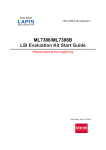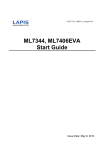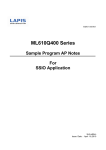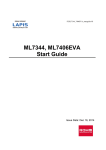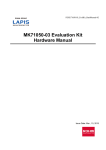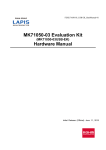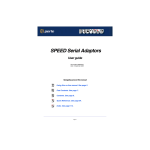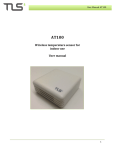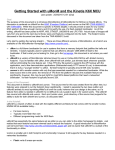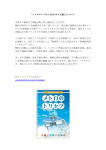Download ML7396 Family LSI Evaluation Kit Start Guide
Transcript
FEXL7396_EVA_startguide-03 ML7396 Family LSI Evaluation Kit Start Guide ※ Please read first Data: Feb 28, 2013 ML7396 Family Evaluation Kit StartGuide Introduction Thank you very much for purchasing products of our company. Before using this product, please use correctly after reading this “start guide”. Moreover, please keep it carefully even after reading this. This start guide indicates enclosure attachment ant the connection method. The manual shown in the following other than this document is prepared. Please check if needed. ML7396 or ML7396A_B_E Datasheet ML7396 Family LSI Design Guide ML7396 Family LSI simple MAC User’s Manual 1 ML7396 Family Evaluation Kit StartGuide Notation Classification Notation z Numeric value 0xnn 0bnnnn Represents a hexadecimal number. Represents a binary number. z Address 0xnnnn_nnnn Represents a hexadecimal number. (indicates 0xnnnnnnnn) z Unit word, W byte, B Mega, M Kilo, K (uppercase) Kilo, k (lowercase) Milli, m Micro, μ Nano, n Second, s (lowercase) 1 word = 32 bits 1 byte = 8 bits 106 210=1024 103=1000 10-3 10-6 10-9 Second z Term "H" level Signal level on the high voltage side; indicates the voltage level of VIH and VOH as defined in electrical characteristics. Signal level on the low voltage side; indicates the voltage level of VIL and VOL as defined in electrical characteristics. "L" level Description z Register description Read/write attribute: R indicates read-enabled; W indicates write-enabled. MSB: Most significant bit in an 8-bit register (memory) LSB: Least significant bit in an 8-bit register (memory) 2 ML7396 Family Evaluation Kit StartGuide Table of Contents 1. Attention on the handling of this product ............................................................................................................... 4 2. Setup Flow ................................................................................................................................................................. 5 STEP1 STEP2 STEP3 CHECK THE CONTENTS OF PACKING.............................................................................................................5 CONNECT EVALUATION BOARD AND MCU BOARD ........................................................................................ 6 SETUP SERIAL COMMUNICATION SOFTWARE ................................................................................................ 7 REVISION HISTORY ................................................................................................................................................. 10 ■NOTES....................................................................................................................................................................... 11 3 ML7396 Family Evaluation Kit StartGuide 1. Attention on the handling of this product ・ ・ ・ ・ ・ ・ This product is evaluation kit. It is available for evaluation only. Please use the application software of this product with the PC with which Japanese version Windows XP is installed. It will become infringement of copyright, if all or apart of software of this product is reproduced without permission of copyright or duplicate things are distributed. Any responsibility cannot be taken about reconstruction and illegal use of this product. If the example of a harmful electric wave interference should occur from this product, please change operating frequency promptly, or suspend the output of an electric wave, and perform disposal for interference evasion etc. The evaluation board at the time of shipment is set as the constant of the data rate of 200kbps or less, and a 920MHz band. When evaluated except this conditions, please use it after changing a constant with reference to a design guide. 4 ML7396 Family Evaluation Kit StartGuide 2. Setup Flow This is flow from check of contents of packing to an assembly STEP 1 Check the contents of packing STEP 2 Connect evaluation board and MCU board STEP 3 Setup serial communication soft-ware STEP1 Check the contents of packing Please check when open the box and all the following articles are assembled first. If it should run short or should have damaged, please inform a purchasing agency. *1 *2 *3 CD-ROM and BNC cable are packed only when first time purchase. BNC cable is used when BER measurement. By shipment time, mounting parts etc may differ from a photograph in part. Please prepare a stabilized power supply, a RS-232C cable(straight), and serial communication software(TeraTerm). □ ML7396 Evaluation Board…1 □ □ Rohm/Lapis Semiconductor MCU Board…1 (ML610Q482 Reference Board) Power Supply Cable…1 □ CD-ROM…1 (First time purchase only) □ 5 BNC Cable…2 (First time purchase only) ML7396 Family Evaluation Kit StartGuide STEP2 Connect evaluation board and MCU board This chapter explains the connection method of an evaluation board and a MCU board. *1 When you connect each boar or you remove, please be sure to operate by power supply OFF state. Please connect the connector of an evaluation board and a MCU board as shown in below figure. *2 *3 If a board is put aslant, there is risk of breakage of a connector. If it is made to fall where a MCU board is put in an evaluation board or a strong shock is given, there is risk of breakage of a connector. After use, please remove and keep an evaluation board from a MCU board. Connector of evaluation board Connector of MCU board Evaluation Board MCU Board After connection Connect evaluation board and MCU board 6 ML7396 Family Evaluation Kit StartGuide STEP3 Setup serial communication software This chapter explains the setup of serial communication software used for operation of an evaluation kit. (Note) Tera Term(Freeware) is recommended as serial communication software. The macro used by simple MAC is described by the macro language of Tera Term. Please download before beginning this operation. 1. Install Tera Term to a PC which is used for evaluation. 2. Connect Evaluation board and MCU board. 3. Connect MCU board to a PC which Tera Term is installed by a RS-232C cable(Straight). 4. Start Tera Term. After start, the screen shown in Fig.1 is displayed. Fig.1 Tera Term start up screen 5. Select “Serial”, and select COM port from “Port:” box. 6. After starting, select ”Setup” Menu => “Serial port…”, change setup into reference for Fig.2, and push the “OK” botton. Setting valu Baud Rate: 38400 Data: 8 bit Parity: none Stop: 1 bit Flow Control: hardware 7. Select “Setup” Menu => “Terminal…”, change setup into reference for Fig.2, and push the “OK” botton. Setting value New Line Recei ve: CR+LF Transmit: CR Local echo: Check ON 7 ML7396 Family Evaluation Kit StartGuide Terminal setting screen Serial port setting screen Fig.2 Tera Term communication setting 8 ML7396 Family Evaluation Kit StartGuide 8. Turn on power supply of evaluation board. 9. Input “RREG 6C” from serial communication software. If “OK 88” is displayed as shown in Fig.3, connection is success. Fig.3 After input “RREG 6C” Preparation of this product is completion above. After this preparation, please carry out a communication test and check the connection state, and operating correctly, after referring to an attached simple MAC user’s manual. 9 ML7396 Family Evaluation Kit StartGuide REVISION HISTORY Document No. Date Page Previous Edition Current Edition Description FEXL7396 EVA_ startguide-01 – – – – FEXL7396 EVA_ startguide-02 – – – – FEXL7396 EVA_ startguide-03 Feb 27, 2013 – – (Note) First edition Corrections in spelling, improvements in the description are not included in the Revision history. 10 ML7396 Family Evaluation Kit StartGuide ■NOTES No copying or reproduction of this document, in part or in whole, is permitted without the consent of LAPIS Semiconductor Co., Ltd. The content specified herein is subject to change for improvement without notice. The content specified herein is for the purpose of introducing LAPIS Semiconductor's products (hereinafter "Products"). If you wish to use any such Product, please be sure to refer to the specifications, which can be obtained from LAPIS Semiconductor upon request. Examples of application circuits, circuit constants and any other information contained herein illustrate the standard usage and operations of the Products. The peripheral conditions must be taken into account when designing circuits for mass production. Great care was taken in ensuring the accuracy of the information specified in this document. However, should you incur any damage arising from any inaccuracy or misprint of such information, LAPIS Semiconductor shall bear no responsibility for such damage. The technical information specified herein is intended only to show the typical functions of and examples of application circuits for the Products. LAPIS Semiconductor does not grant you, explicitly or implicitly, any license to use or exercise intellectual property or other rights held by LAPIS Semiconductor and other parties. LAPIS Semiconductor shall bear no responsibility whatsoever for any dispute arising from the use of such technical information. The Products specified in this document are intended to be used with general-use electronic equipment or devices (such as audio visual equipment, office-automation equipment, communication devices, electronic appliances and amusement devices). The Products specified in this document are not designed to be radiation tolerant. While LAPIS Semiconductor always makes efforts to enhance the quality and reliability of its Products, a Product may fail or malfunction for a variety of reasons. Please be sure to implement in your equipment using the Products safety measures to guard against the possibility of physical injury, fire or any other damage caused in the event of the failure of any Product, such as derating, redundancy, fire control and fail-safe designs. LAPIS Semiconductor shall bear no responsibility whatsoever for your use of any Product outside of the prescribed scope or not in accordance with the instruction manual. The Products are not designed or manufactured to be used with any equipment, device or system which requires an extremely high level of reliability the failure or malfunction of which may result in a direct threat to human life or create a risk of human injury (such as a medical instrument, transportation equipment, aerospace machinery, nuclear-reactor controller, fuel-controller or other safety device). LAPIS Semiconductor shall bear no responsibility in any way for use of any of the Products for the above special purposes. If a Product is intended to be used for any such special purpose, please contact a ROHM sales representative before purchasing. If you intend to export or ship overseas any Product or technology specified herein that may be controlled under the Foreign Exchange and the Foreign Trade Law, you will be required to obtain a license or permit under the Law. Copyright 2013 LAPIS Semiconductor Co., Ltd. 11













